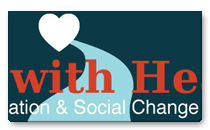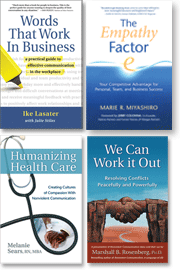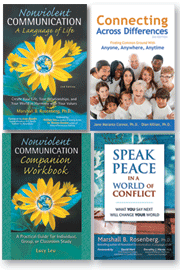Addressing Workplace Conflict... continued
One of the things I have learned about dealing with interpersonal and organizational conflict is that we have to be able to express to others what is it they are doing that is not making our lives wonderful. Whether that is one person or a group of people, we need to be able to make clear observations about what it is someone is doing and communicate that to them without bringing out any defensive energy.
Saying to an employee, "You are always late, what are we going to do about this" and saying that in the nicest of ways is still likely to get a defensive reaction of "No I'm not always late." Even if we used "I" statements in that and said, "I am concerned that you are always late." If we truly want to address the behavior, we must be able to make a clear observation free of moral judgment, evaluation or diagnosis. We can do this by stating just the facts as we know them. Example: "This is the 3rd day you have come in past 9 o'clock"
This separates the person from the action. We need to do this so we can connect and bond with them in meaningful ways. George Kohlrieser states in his book, Hostage at the Table that, "Hostage negotiators are able to negotiate with desperate people because they are able to bond with them, irrespective of the acts that such individuals may have committed. Without a bond, there will not be a negotiation. Every act of violence involves a break or disruption in the bonding process."
What Kohlrieser is saying is nothing new. We have all heard the saying, "keep your friends close and your enemies closer." We can disagree with what a person is doing and still connect with that person in meaningful ways to create change. It is what Gandhi, King and other peace figures in society have said for decades. We must separate people from problems. Martin Luther King, Jr. wrote in his 1958 book Stride Toward Freedom, "Nonviolence seeks to defeat injustice, not people."
By separating the actions from the person and creating a bond, we are connecting with the person. We are able to open the doors for dialogue and communication. We cannot solve a problem or conflict with others until we have created a safe space for negotiation and problem solving to happen.
By creating a clear observation of the behavior, we are now in a position to see the person as a person and the action as behavior. We can begin the process of bonding with the person while addressing the problem or conflict separately by creating a place of trust not a place of defensiveness.
To take this first step, think of something, someone is doing right now that you would like to talk with them about and write down in a statement form the "observation" you would like to express to this person. Try using this form: "When I see you (or hear you say) ........" Be specific and free of diagnosis, evaluation, judgments, and comparisons to others. Just state the facts about the behavior.
Understand the Role of Needs in Behavior and the Resulting Feelings Attached to Those Needs
French author, Thomas D'Ansembourg in his book, Being Genuine: How to Stop Being Nice and Start Being Real uses the metaphor of a car's dashboard to explain the relationship between our feelings and our needs. He explains that just as the lights and indicators on the dashboard tell the driver what the car needs like oil or gas, our feelings are physical indicators of what needs of ours are not met or met. If we are feeling hungry it is an indicator we need sustenance. If we are feeling tired, it is an indicator we need rest.
Once we have learned that our needs are the cause of our feelings, we can stop blaming other people for "making us feel" anything. Also, by being able to understand a person's feelings and the needs behind those feelings, we are better able to create the bond that is vital to resolving conflict.
Be sure you are expressing a feeling and not a thought. When you use the words "I feel" avoid following that with "as if" or "like" and most importantly don't follow it with a person's name or pronouns like "you" or "he." Feelings are physical emotions caused by chemicals in our brains. Ask yourself if the word you are using is really a feeling or if you have chosen action words instead.
Action words are words we use as if they are feelings when they actually imply someone is doing something to us. These are the words that invoke defenses and build walls. Examples of these words would be "attacked" or "abused." These words fail to connect others with what is really going on inside us therefore acting as a block to the bond we are trying to create.
Maslow, Glasser, Rosenberg and even Kohlrieser all agree as psychologists that all human behavior is in the service of human needs. Everything we do is an attempt to meet our needs. As managers or supervisors, understanding what needs an individual person is trying to meet with their actions can more easily separate the person from the problem. We can see that the strategies they choose may be in conflict with our values and open the opportunity for us to explore new strategies to meet their needs as well as our own. With the right strategies and meaningful dialogue, everyone's needs can be met.
Add to your statement from step one your feelings and needs. It might read something like this..."When I see you ...(insert observation from step one), I feel ...(insert a real emotion)... because I need or value ...(now insert a need not a strategy)...
Know the Difference Between Requests and Demands
Once we you have identified the behavior and turned it into a clear observation statement and you have expressed your feelings and needs in relation to this observation, it is time to form a request that either suggests actions to take that will meet needs or that creates connection and understanding about what we said.
For instance, if we where talking about the late employee we might say, "John, I see this is the 3rd day in a row that you have come in past 9 O'clock. I am feeling frustrated because I really need some acknowledgment of our agreement at the staff meeting to all be here at 9. Just so I know I am being clear, would you be willing to tell me what you are hearing me say right now?"
This gives the other person a chance to clarify what is going on with them. The employee might reply by saying, "You think I don't care about this job" and we can then see that we haven't made the connection that we needed to manage the conflict. We now have a chance to "reconnect" and "bond" with this person and find out what is going on for them by listening empathetically for their needs and feelings regardless what words they use.
When our request is an action request, we connect best when we ask for specific actions, in the moment and using positive action language. That means we are going to ask for what we want someone to do as opposed to asking for what we don't want someone to do. We don't want to ask people to "stop" or "not" do something. We instead want to tell them what we "DO" want them to do.
Behind all of this care and attention we take on choosing the right words, we truly make connections and bond when we are focused on the intentions behind our words. It is less likely others will hear our request as a demand if we keep our intention to be connection to what is really going on for them.
Curiosity is the key to connection and bonding with other people. We need to remain curious what is happening for other people and what needs they are trying to meet. Marshall Rosenberg writes in his book Speak Peace that we should ask ourselves two questions:
What is it that we want someone to do?
What do we want there reasons to be for doing it?
When our requests are heard as demands, people have only have the choices of giving in to what we want out of fear of punishment or the promise of reward or not giving in out of spite. None of those choices are connecting to the energy of doing things because we see the value in doing them. In employment terms, we are talking about the difference between those who do their jobs for the love of their jobs and those who do it because they believe they "have to" in order to survive.
We always want to try and make our requests negotiable so that people have the ability to say "no" and that we are open to the idea that there exist other strategies to meet our needs. When someone says "no" to our request, they are really saying they would like to explore other strategies that would meet "both" our needs.
By being willing to connect with this person and stay bonded to them during the conflict at hand, we can explore ideas of getting everyone's needs met regardless what has happen. If everyone is getting their needs met, then the conflict isn't much of a conflict anymore.
Add to your statement from step one and step two a clear request. It might read something like this: "When I see you ...(insert observation from step one)... I feel ...(insert a real emotion)... because I need or value (insert a need not a strategy)... Lastly, request, rather than demand, that which would meet these needs, being prepared for a "no" and prepared to explore other strategies that meet everyone's needs.
This article is based on NVC, the work of Marshall Rosenberg and the Center for Nonviolent Communication and also George Kohlrieser and the book, Hostage at the Table: How Leaders Can Overcome Conflict, Influence Others, and Raise Performance
Joe Brummer is an experienced trainer and mediator and the Associate Executive Director of Community Mediation, Inc. in Hamden, CT. He has presented workshops in mediation and conflict resolution at many area schools, universities, businesses and most recently a presentation for UNSECO. He has clocked hundreds of hours at the mediation table facilitating in a wide variety of areas including workplace disputes, landlord/tenant conflicts, neighborhood disputes, civil law suits, and victim offender mediation. He also serves on the Board for the National Association for Community Mediation. He was trained at the Institute for the Study and Practice of Nonviolence where he worked with at-risk youth to teach nonviolence. Joe has become well respected for sharing his experiences with Nonviolent Communication with both youth and adults. He has shared NVC with social workers, law enforcement, and nonprofit organizations all throughout the New England area. You can learn more about Joe by visiting www.community-mediation.org.
Keep learning these vital
communication skills with these books and training
resources:
This Month's Specials:
- NVC Workplace Communication Book Package Save 65% off list price or eBook Package Save 65% off list price through Apr. 30, 2013
- NVC Starter Kit Book Package Save 65% off list price or eBook Package Save 65% off list price through Apr. 30, 2013
Every Day Book
Package Specials:
- NVC Marshall B. Rosenberg, Ph.D. Book Package and eBook Package - Save 50%-65% on this book package every day from PuddleDancer Press
- NVC Reference Library Package and eBook Package - Save 55%-65% on this book package every day from PuddleDancer Press
- Save at least 30%-55% off of retail on all other Books and Packages every day.










